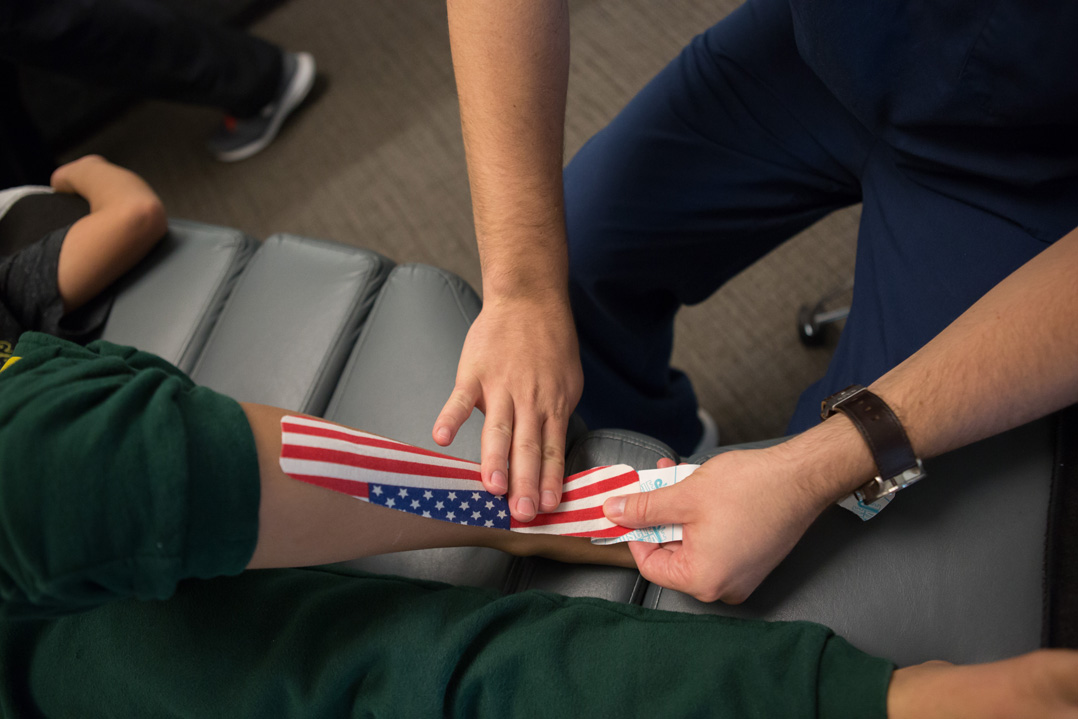Real Deal or Placebo?
Widespread use at the London Olympics has brought significant attention to rehabilitative taping
By Davis Koh, DPT, MBA, GCS, CSCS
Posted on: October 2, 2012
Vol. 23 • Issue 20 • Page 28
Taping
Millions of people watched athletes compete in various sports at the 2012 London Olympics while wearing brightly colored tape in different sizes and shapes. Many have asked me about this type of tape and why it was being used. How is it different from traditional athletic tape? Is it only for Olympic athletes? Does it just have a placebo effect? The product they saw was elastic rehabilitative tape.
I have used and been trained in five different brands of rehabilitative tape and have attended seminars over the years utilizing rehabilitative tape along fascial chains, for sports taping and splinting, among many other uses. I’ve also used rehabilitative tape extensively in my physical therapy lab as well as in national/international venues such as the 2011 Pan American Games, U.S. Olympic Training Centers, FIVB Volleyball World Championships, USA Bobsled and Skeleton Federation international events, ASP pro surfing events and AVP pro beach volleyball tournaments.
Proper Tension
Some of the general purposes of rehabilitative tape are to provide neuro facilitation, structural support and edema control, as well as improve circulation into different areas, affecting different tissues. The key is how the tape is placed and at what tension and direction.
For taping concepts, to affect neurosensory you’d stretch the tissue and not the tape. In the case of structural support, stretch the tape and not the tissue. If it’s microcirculatory, such as for edema control or to improve lymph drainage, stretch the tape and the tissue. For lymph drainage, the desired goal is to have an accordion effect, creating waves that help push fluid through tissues. When you do it correctly, the tape will have a wave-like appearance on the skin itself. For structural support, take the patient into the painful range of motion, then come off it a bit and lay the tape down across the body part as a cue to avoid that painful range of motion.
How is rehabilitative tape different from traditional athletic tape? For one, it’s latex-free and typically made of 100-percent cotton or a synthetic blend so you can bathe/shower with it. In certain situations, rehabilitative tape will adhere to the skin better than normal athletic tape. For example, when I use the tape during international beach volleyball tournaments, the dirt and sand make it difficult for normal athletic tape to stick properly. I’ve found that rehabilitative tape provides not only support but also better stickiness when on-the-spot taping is necessary in live tournament situations.
As another example, a therapist who works at my facility was instructed by an orthopedic surgeon in a taping procedure using paper tape to help with neuroma-like symptoms in her toes. However, within 15 minutes of her leaving the office, the paper tape kept ripping off. When I used rehabilitative tape instead to apply the same taping technique around her toes, it lasted for days rather than minutes.
Rehabilitative tape allows you to also put different modalities such as ice on top once it has adhered to the skin. An example would be a patient with an ankle sprain. Sometimes I use an open-basket weave for an ankle inversion sprain, applying athletic tape for support and then combining it with rehabilitative tape on the dorsum of the foot and ankle for edema reduction.
 Some disadvantages are that when true stability and immobility are needed, rehabilitative tape is not as strong as traditional tape for that specific reason. Rehabilitative tape, depending on the tape and skin type, manufacturer or brand, color dyes, synthetic vs. cotton rehabilitative tape etc., will determine how well it adheres to a person’s skin. Aside from the usual contraindications such as infection and active cancer, rehabilitative tape should also not be placed over certain areas such as the scalene triangle or axilla due to its impact on bioreceptors/vasovagal tension, affecting blood pressure. Some disadvantages are that when true stability and immobility are needed, rehabilitative tape is not as strong as traditional tape for that specific reason. Rehabilitative tape, depending on the tape and skin type, manufacturer or brand, color dyes, synthetic vs. cotton rehabilitative tape etc., will determine how well it adheres to a person’s skin. Aside from the usual contraindications such as infection and active cancer, rehabilitative tape should also not be placed over certain areas such as the scalene triangle or axilla due to its impact on bioreceptors/vasovagal tension, affecting blood pressure. |
Less is More
Less is more when it comes to rehabilitative tape and most recent research shows that only 10 percent of the total length of tape is needed for therapeutic effect, especially for edema control. Anything more than that is the primary cause of skin stretching, bumping, itchiness and pain that patients will sometimes talk about when rehabilitative tape is applied to them.
Can rehabilitative tape actually affect tissues and create mechanical changes or is it just a placebo? Since personal testimonies of dramatic symptom improvements using rehabilitative tape still fall under the cloud of a possible placebo effect, I thought I’d go the opposite route and share a few stories of soft tissue being negatively affected. Based on my own experiences and those of trusted colleagues with no vested interest either way, I have a hard time believing rehabilitative tape is only a placebo.
Before I started using rehabilitative tape in my practice, a friend of mine attended an in-service on rehabilitative taping where his knee was used for a demonstration. He didn’t have a lateral tracking issue, but the intention was to show how rehabilitative tape could be applied to help correct lateral patellar tracking problems. He decided to keep wearing it to see how long it would last but removed the tape after a day because his knee began to hurt with walking. It continued to be painful for the next three weeks. My friend was amazed because he barely felt the tape while it was applied and didn’t really believe it was doing anything at all.
Similarly, an OT colleague told me after taking a rehabilitative taping course that he woke up the same night with severe pain in his left glute. He realized he had forgotten to take off some rehabilitative tape that was still placed along his piriformis. When he removed the tape, he felt better immediately and was able to sleep.
Adversely affecting movement or asymptomatic soft tissue as these examples suggest would run counter to the placebo hypothesis that rehabilitative tape does absolutely nothing physiologically. This is in addition to countless success stories of pain relief, dramatic decrease in surgical scar reduction and bruising, improved edema control and biomechanics that I’ve seen over the years from using rehabilitative tape.
So is it a placebo or can tape affect soft tissue, movement patterns and circulation? We can go back and forth on the literature and case studies. For every article stating its effectiveness, there’s another showing a lack of any therapeutic effect.
I believe the issue comes down to the clinician and how properly the tape is applied. The right amount of tension and correct location, for the right diagnosis, all play a part in its ability to facilitate movement correction, pain relief, neuromuscular facilitation and muscular inhibition.
As far as whether it’s a placebo, my answer is both yes and no. For some athletes and patients, I’m sure rehabilitative tape does have a placebo effect just like any other modality can. Is it a good alternative to traditional athletic tape? Outside of some of the contraindications mentioned earlier, I believe it is. Rehabilitative tape is hypoallergenic, more comfortable, enables more mobility, allows other modalities to be applied in conjunction, and causes decreased skin reactions for some patients compared to athletic tape.
If a clinician has been trained properly, rehabilitative tape is easy to apply. Whether rehabilitative tape does what it claims to the fullest extent is still up for debate, but I believe it has a place in rehabilitation. The extent of its benefits is in large part dependent on the practitioner, his skill level or knowledge regarding the tape, and applying it for the appropriate diagnosis and situation.
Davis Koh is president and CEO of Koh Physical Therapy Lab in Irvine, CA. He has been invited as a consultant/speaker by organizations such as TaylorMade, Skechers USA, CPTA, NSCA, the U.S. government and U.S. Olympic Committee.
Advance HealthCare Network for PHYSICAL THERAPY & REHAB MEDICINE article

